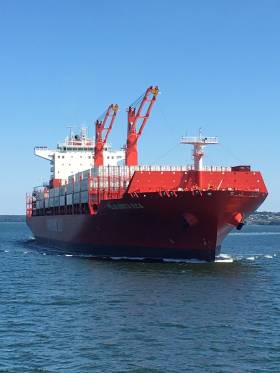Displaying items by tag: New STS cranes
Port of Liverpool’s Terminal 1 Container Capacity Increases by 30% With New Cranes In Service
At the Port of Liverpool's Terminal 1, container capacity increases by 30% as new cranes become fully operational at the north-west England port.
The port operated by Peel Ports, announced its new additional cranes which are now fully operational and will deliver a 30% uplift in quayside capacity at Terminal 1.
With the completion and commissioning of the additional ship-to-shore (STS) container cranes will service the needs of specialist carriers such as Atlantic Container Line (ACL) see above photo Afloat adds is a 'G4' class vessel. In addition to their services operated by containerships BG Freightline, WEC and Borchard XPS.
The 12-week commissioning programme was fully completed in January this year and is the operator’s latest investment to meet additional demand and future proof the Port’s capacity.
This investment by Peel Ports sees an additional two cranes added to the six already in place, which will allow for much greater efficiency and faster turnaround times for the loading and discharging of taller container vessels.
Using the latest state of art technology, the new cranes utilise high tensile steel and lattice boom and beam construction and are designed and built by Liebherr Container Cranes Limited.
The highly efficient cranes feature improved functionality to ensure the highest performance is maintained consistently. The new cranes also have greater connectivity, so they can be monitored remotely to deliver optimum performance with the most efficient use of power.
The announcement comes on the back of last year’s successful completion of its second phase of investments for Terminal 2, where the port operator welcomed ten new cantilever rail-mounted gantry (CRMG) cranes, which led to the opening of an additional 15 acres of yard capacity as part of the £400 million Liverpool2 project.
With the majority of the UK and Ireland’s population closer to The Port of Liverpool, rather than southern ports, continued investment in securing sustainable growth is key for Peel Ports.
The location of the Port is of strategic importance to major importers and exporters of goods as it offers unrivalled connectivity to Ireland and access to a catchment area of over 35 million people.
David Huck, Chief Operating Officer at Peel Ports said “Innovation and the continued investment in infrastructure and our people are at the heart of our business strategy. We are delighted to see these new cranes now in full operation. They represent a significant investment in our capability and highlight our commitment to ensuing the Port of Liverpool continues to provide a highly efficient service.”
“Together with the completion of the final stage of development and increased capacity at Terminal 2 last year, the Port of Liverpool has never been in better shape to handle increased cargo volumes and deliver further transformational service and choice to our customers.”
Irish Built Liebherr Cranes for Port of Cork
#PortofCork - A significant deal has been signed by Liebherr Container Cranes to supply two large gantry cranes to the Port of Cork.
The twin cranes reports The Kerryman will be located at the new container terminal at Ringaskiddy - will be designed and built at Liebherr's plant in Killarney and are due to be delivered to the Port of Cork by April 2020.
Director of Liebherr Container Cranes Pat O'Leary welcomed the deal. "We are delighted to have received this order and to continue our long-standing relationship with the Port of Cork," said Mr O'Leary.
"In the 1970s, Liebherr Container Cranes supplied the first ship to shore container cranes to the port. Since that time we have supplied further cranes, including two grab cranes; two STS cranes in 1991 and 1999; as well as a rubber tyre gantry crane, all of which continue to be key elements of the port's infrastructure".
He added "The signing of a contract for the supply of two new state-of-the-art STS cranes will help drive port productivity and boost business, not only in Cork, but also throughout Ireland."
Afloat adds these STS, ship to shore cranes are also the same type of infrastructure assembled in Cork Dockyard earlier this year and carried as deck cargo for clients ABP's Port of Hull.
As for Cork's new €80m Container Terminal, construction began in June. The project is also to feature a new public marine leisure amenity at Paddy’s Point in addition a €1m community gain fund for the Ringaskiddy area.






























































